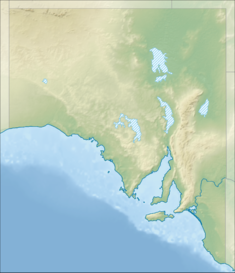Happy Valley Reservoir
| Happy Valley Reservoir | |
|---|---|

Aerial view of Happy Valley Reservoir in early 2007
|
|
|
Location of Happy Valley Reservoir in Australia South Australia#Australia Greater Adelaide
|
|
| Country | Australia |
| Location | South Australia |
| Coordinates | 35°04′23″S 138°34′19″E / 35.073°S 138.572°ECoordinates: 35°04′23″S 138°34′19″E / 35.073°S 138.572°E |
| Purpose | Reservoir |
| Construction began | 1892 |
| Opening date | 1897 |
| Construction cost | A$1.8 million |
| Dam and spillways | |
| Type of dam | Earth with clay core |
| Height | 23.6 metres (77 ft) |
| Length | 1,155 metres (3,789 ft) |
| Reservoir | |
| Total capacity | 11.5 gigalitres (410,000,000 cu ft) |
| Surface area | 1.88 km2 (0.73 sq mi) |
The Happy Valley Reservoir is a water reservoir located in Adelaide, Australia. Constructed when the total population of Adelaide numbered 315,200 (1893 census), the Happy Valley Reservoir now supplies over a half a million people, from Adelaide's southern extent to the city-centre. It is also home to lots of wildlife including many kangaroos.
Built between 1892 and 1897 at a cost of A$1.8 million it was the third reservoir constructed in South Australia as a supplement to the Thorndon Park Reservoir (built 1860) and the Hope Valley Reservoir (built 1872).
The original Happy Valley township, school and cemetery were completely flooded by the new reservoir requiring their relocation. The township was moved to the east while the cemetery, which is still in use today, was moved to the west and relocated alongside the base of the dam wall. The school, originally located on Candy road, was relocated south to two acres of land on Red Hill Road (later renamed Education road) which was donated by local farmer Harry Mason. While some students attended O'Halloran Hill or Clarendon schools for the 18 months that the Happy Valley school was closed, some did not attend any school until it was re-opened on 26 September 1898. The school closed in December 1979 and re-opened on a new site on the other side of the road directly opposite.
The reservoir acts as a 'holding pond' for water directed to it from the Clarendon Weir via a five km long underground tunnel. The 1.8 m diameter tunnel was bored simultaneously from both ends and when meeting had a deviation of 25 mm. Its deepest point underground is 122 m where it passes through a hill. On 7 August 1896 the tunnel's inlet valve was opened by the Governor of South Australia, Sir Thomas Fowell Buxton and the reservoir began filling.
Initially 15 kilometres from Adelaide, the reservoir is now largely enveloped by the city's southern suburbs, of which the relocated Happy Valley village is now one. Although the reservoir is relatively small in capacity; holding only 11,500 megalitres and is dwarfed by Mount Bold Reservoir which is at least four times larger, it is the site of the biggest water treatment plant in Adelaide and is responsible for providing more than 40% of the city's water.
...
Wikipedia


